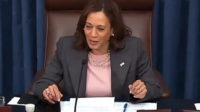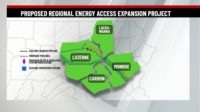As companies grapple with proposed federal requirements to disclose carbon emissions, some seek stronger signals from the government that it will provide sustained support for decarbonization efforts.
These include passage of climate-related provisions from the stalled Build Back Better bill, which would provide production tax credits for a variety of carbon-reduction projects, more funding for R&D and other programs, and a price on carbon, several corporate leaders said May 25.
A U.S. Security and Exchange Commission March 21 proposal would require publicly traded firms to disclose not only their own carbon emissions, but also the emissions of contractors and suppliers. Released not long before the U.N.’s Intergovernmental Panel on Climate Change’s April 4 report stating that the planet is on its way to becoming “uninhabitable” without drastic cuts in greenhouse gas emissions, the proposed rules are another factor pushing corporations to try to reduce carbon emissions. Comments on the proposal are due on June 17.
The SEC also announced a proposal on May 25 to require investment funds and advisors to disclose to investors more climate change and other environmental, social and governance (ESG) related information.
But getting there is the hard part, said several executives at the nonprofit Center for Climate and Energy Solutions’ Climate Leadership conference in Arlington, Va.
“We will do our part, but we need the government to do its part, too,” said Calvin Butler, senior executive vice president and chief operating officer of Exelon.
The company pledged in 2021 to achieve net zero operating emissions by 2050, and has set a 50% electrification goal for its vehicle fleet by 2030. But what’s essential “is the technology to help us do that,” Butler said. Some of that technology is not yet developed or commercially available.
Better Tracking Technology Needed
The lack of technology, including systems to track and compile data related to emissions, is making it more challenging for corporations to figure out how to meet ambitious emissions reduction targets, several company officials said.
“Having [emissions] targets is the first step,” said Michael LeMonds, vice president of environment, land and government affairs at Holcim U.S., the domestic unit of the global cement manufacturer. “Meeting those commitments is another.”
Nanette Lockwood, senior director of policy and advocacy for Trane Technologies, noted that the U.S. is lagging behind meeting its commitments for the 2016 Kigali amendment to the Montreal Protocol that calls for the gradual phaseout of hydrofluorocarbons (HFCs). Having model building codes in place at the state level that advocate use of low global warming potential alternatives would move the needle forward in reducing greenhouse gas emissions in the U.S., she said.
Federal officials at the conference said the Biden administration seeks to incorporate climate and environmental justice-related goals into virtually every department and regulatory action.
Andrew Mayock, White House Council on Environmental Quality chief sustainability officer, who has served in both the Obama and the Biden administrations, observed that he has seen a shift among federal agency employees. In the past, he felt he had to “pester” agencies to include funding in their budgets for climate-relate goals during the Obama administration. Now, he said, they are “totally on board.”
Engineering and construction firms have a role to play to help corporations and municipalities figure out how to measure and reduce carbon emissions and develop actionable plans, Jason Rowell, an associate vice president and new energy solutions leader at Black & Veatch, told ENR. Many companies have made commitments to reduce emissions, “but how to do it is very much an unknown,” he added. “A lot of the technologies beyond switching to renewable power are still in development.”
Black & Veatch made its own commitment last year to discontinue working on new coal-fired plants internationally as part of its own sustainable and emission reduction goals. “We can’t be on both sides of the fence; we can’t keep building new coal yet making a major push to be a more sustainable firm and improve our ESG position.”
Climate Risk Analysis by the Numbers
Meanwhile, a new survey of nearly 40 public companies shows that firms say they are already spending an average of $533,000 to comply with climate change risk reporting that would be covered in the SEC proposal when it takes effect, close to the agency's estimate of $530,000.
The study, by consulting firm ERM, also noted, however, that the average expense respondents incurred rose to $677,000 for reporting on two categories excluded in SEC cost calculations: responding to climate-related shareholder proposals, and developing low-carbon transition plans and other voluntary analysis and disclosure.
Survey respondents, which were not identified, vary in market capitalization from less than $1 billion to more than $200 billion, have between 1,000 and 250,000 employees, and operate in business sectors that include health care, energy, utilities, real estate, financial services, transportation and IT.
Analyzing and disclosing greenhouse gas emissions was the single costliest reporting category, averaging $237,000 per firm, said ERM.
The companies said that the biggest benefit of climate-related disclosure activity was meeting client demand for that information, followed by better performance in meeting sustainability, climate and ESG goals, improved access to data to sharpen business strategy and attract and retain employees, and lower cost of capital, among others.
“The U.S. is entering a new era of climate change reporting, driven by the need for clear and consistent data that will help investors to assess and compare organizations’ financial exposure and risk management strategies during the transition to a decarbonized economy,” said Mark Lee, director of ERM's SustainAbility Institute.
ERM also analyzed responses from 35 institutional investors, which said they annually spend $1.37 million on average to collect, analyze and report on climate data.
The survey was conducted for Ceres, a shareholder advocacy nonprofit, and Persefoni, a carbon accounting software firm.







Post a comment to this article
Report Abusive Comment